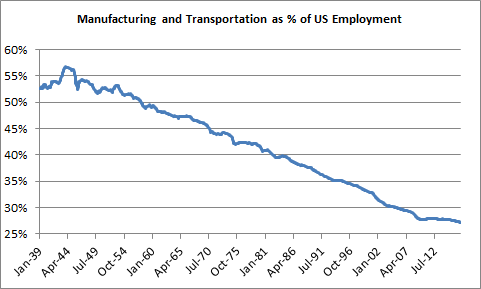I read a common narrative these days about how the US economy is slowing because it’s weakening, becoming less dynamic and less productive. I’ve countered some of this over time by arguing that yes, we’re slowing, but we’re just normalizing and actually stabilizing (in other words, the idea of “secular stagnation” is another case of short-termism). That is, if you look at the historical rate of growth you’ll find that the past 75 years were an outlier and that we’re just reverting to the mean.

But I would also argue that there’s something else going on here. It’s not just that the US economy is slowing because 2-3% is a more sustainable and normalized rate of growth. We’re slowing because we’re becoming more dynamic and diverse. For instance, in the boom period of the 1900s, the US economy was rather concentrated in manufacturing and transportation. As these segments of the economy boomed the entire US economy boomed. But these booms also coincided with great instability and persistent financial panics and depressions. It was like a concentrated stock market bet. But as the US economy has become more diverse the rate of growth has started to slow and stabilize.¹
To visualize this we can look at how concentrated US employment used to be in manufacturing and transportation. Over time the US economy has boomed from a concentrated bet on a few specific industries to a highly diverse bet on many sectors.

And here’s where it gets interesting. If you look at the 5-year average rate of growth in the US economy you will notice a clear correlation to this increasing diversity. The US economy has slowed in part because it is becoming so diverse. Again, it’s like taking a Nasdaq concentrated stock market portfolio and diversifying it across a bunch of other slower growth sectors. And as these slower growth sectors have expanded over time they’ve bolstered the growth of the US economy by making it more diverse, but slower in its rate of growth. We are, in portfolio management speak, earning a higher risk-adjusted rate of growth which is actually an improvement over the period of high and unstable growth.











Leave A Comment